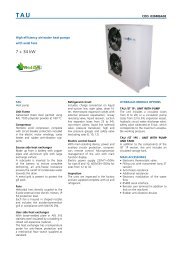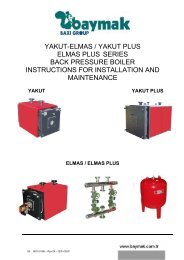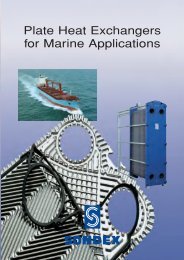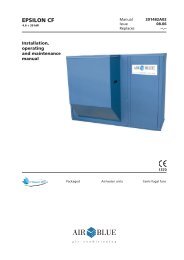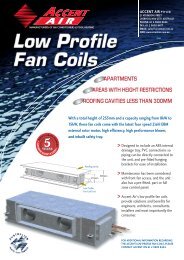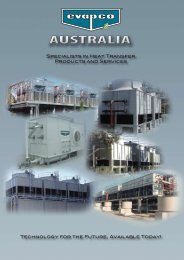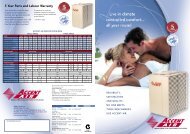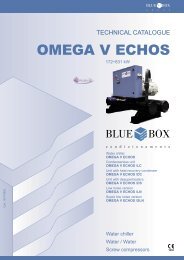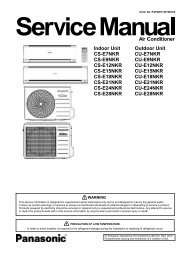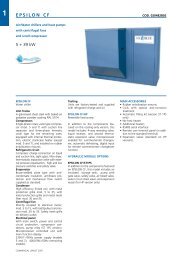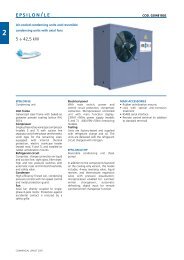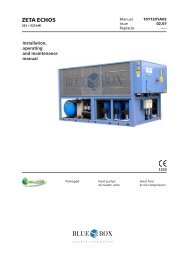KAPPA V ECHOS AC IOM.pdf - Industrial Air
KAPPA V ECHOS AC IOM.pdf - Industrial Air
KAPPA V ECHOS AC IOM.pdf - Industrial Air
You also want an ePaper? Increase the reach of your titles
YUMPU automatically turns print PDFs into web optimized ePapers that Google loves.
REFRIGERANT SAFETY DATA - R407C<br />
1. IDENTIFICATION OF<br />
THE SUBSTANCE<br />
2. COMPOSITION /<br />
INFORMATION ON<br />
INGREDIENTS<br />
3. HAZARDS<br />
IDENTIFICATION:<br />
4. FIRST-AID<br />
MEASURES:<br />
5. FIRE-FIGHTING<br />
MEASURES:<br />
6. <strong>AC</strong>CIDENTAL<br />
RELEASE MEASURES:<br />
1.1<br />
Identification of the 407C<br />
preparation:<br />
Synonyms: HFC-32lHFC-125IHFG134a<br />
Formula: Mixture<br />
EE-No: difluoromethane (HFC-32) : 200-839-4<br />
1-1-1-2-tetrafluoroethane UHFC-134a) : 212-377-0<br />
pentafluoroethane (HFC-125) : 206-557-8<br />
Chemical Name CAS-No - Wt % - Symbol(s): & phrases "R"<br />
difluoromethane 75/10/5 - 23 - F+;R12<br />
1-2-2-2-tetrafluoroethane 811/97/2 - 52<br />
pentafluoroethane 354/33/ 6 - 25<br />
3.1 Most important<br />
hazards: Liquefied gas: may cause frostbite. Contact with eyes may cause<br />
irritation.<br />
4.1<br />
Eyes Rinse immediately with plenty of water for at least 15 minutes.<br />
Keep eye wide open while rinsing. If symptoms persist, call a<br />
physician.<br />
Skin Liquefied gas may cause frostbite. Wash frostbitten areas with<br />
plenty of water. Do not remove clothing. Wash off with warm<br />
water. if skin irritation persists, call a physician.<br />
Inhalation Move to fresh air in case of accidental inhalation of vapours.<br />
Oxygen or artificial respiration if needed. Do not apply artificial<br />
respiration if patient is breathing; Consult a physician after<br />
significant exposure. Do not give adrenaline or similar drugs.<br />
Ingestion Do not induce vomiting without medical advice. Call a physician<br />
immediately. Do not give drugs from adrenaline-ephedrine<br />
group.<br />
General advice Consult a physician alter significant exposure.<br />
5.1 Suitable extinguishing<br />
media:<br />
5.2 Extinguishing media<br />
which must not be<br />
used for safety reasons:<br />
The product itself does not burn. Extinguish with carbon dioxide,<br />
dry chemical, foam or water spray. Use extinguishing measures<br />
that are appropriate to the environment.<br />
None<br />
5.3 Specific hazards: Possibility of generating hazardous reactions during a fire due to<br />
the presence of F and/or Cl groups. Fire or intense heat may<br />
5.4 Special protective<br />
equipment for fire-<br />
fighters:<br />
cause violent rupture of packages.<br />
In case of fire, west a self contained breathing apparatus.<br />
Protective suit.<br />
5.5 Specific methods: Standard procedure for chemical fires. In the event of fire, cool<br />
tanks with water spray.<br />
6.1 Personal precautions: Use personal protective equipment. Evacuate personnel to safe<br />
areas. Do not breath vapours or spray mist. Ensure adequate<br />
6.2 Methods for cleaning<br />
up:<br />
ventilation.<br />
Shut off leaks it without risk. Solid evaporates. Ensure adequate<br />
ventilation.<br />
Blue Box 18





